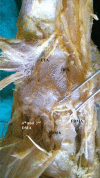Variations in the origin, course and branching pattern of dorsalis pedis artery with clinical significance
- PMID: 33446776
- PMCID: PMC7809105
- DOI: 10.1038/s41598-020-80555-z
Variations in the origin, course and branching pattern of dorsalis pedis artery with clinical significance
Abstract
Pulsations of the dorsalis pedis artery are commonly used to evaluate the peripheral arterial diseases like thromboangiitis obliterans (TAO) or Buerger's disease, in lower limbs. Dorsalis pedis artery is a direct extension from the anterior tibial artery and major vascular supply for the dorsum of the foot. But arterial variations in lower limbs are common due to rich distal anastomoses around the ankle joint. Absence of dorsalis pedis arterial pulse does not indicate peripheral arterial disease always as it is sometimes replaced by the enlarged perforating branch of peroneal artery, it may be absent or very thin, deviate laterally on the dorsum of foot. Aim of the present study is to observe the variations in origin, course and branching pattern of dorsalis pedis artery because of its clinical significance. During routine dissection of lower limbs for undergraduates we came across rare variations in the dorsalis pedis artery in its origin, course and branching pattern. Normal anatomic description was found in 27 limbs. In 13 specimens we noted variations, includes bilateral anomalous origin of dorsalis pedis artery, bilateral lateral deviation of dorsalis pedis artery, double dorsalis pedis artery, trifurcation of dorsalis pedis artery and absence of arcuate artery. Knowledge about the arterial variations around the ankle is important to orthopaedic, vascular surgeons and radiologists to prevent complications during surgical interventions.
Conflict of interest statement
The authors declare no competing interests.
Figures









Similar articles
-
Anatomical variation of the Dorsalis pedis artery in a South African population - A Cadaveric Study.Foot (Edinb). 2018 Jun;35:16-27. doi: 10.1016/j.foot.2018.01.002. Epub 2018 May 10. Foot (Edinb). 2018. PMID: 29753997
-
A cadaveric study showing the anatomical variations in the branches of the dorsalis pedis artery at the level of the ankle joint and its clinical implication in ankle arthroscopy.Ann R Coll Surg Engl. 2017 Apr;99(4):286-288. doi: 10.1308/rcsann.2016.0288. Epub 2016 Sep 23. Ann R Coll Surg Engl. 2017. PMID: 27659360 Free PMC article.
-
Anatomic study of blood supply of the dorsum of the foot and ankle.Arthroscopy. 2006 Mar;22(3):287-90. doi: 10.1016/j.arthro.2005.10.021. Arthroscopy. 2006. PMID: 16517313
-
Two cases of the superficial dorsalis pedis artery observed in man.Ann Anat. 1996 Apr;178(2):183-9. doi: 10.1016/S0940-9602(96)80042-2. Ann Anat. 1996. PMID: 8638773 Review.
-
Should the Histological Examination Be Used in the Diagnosis of Aneurysms of the Dorsalis Pedis Artery? A Case Report and Review of the Literature.Ann Vasc Surg. 2019 Jan;54:336.e1-336.e4. doi: 10.1016/j.avsg.2018.06.023. Epub 2018 Aug 13. Ann Vasc Surg. 2019. PMID: 30114498 Review.
Cited by
-
The Topographic Map of the Midfoot: Implication for Improving Safety of Dorsal Approach of Midfoot Surgeries.J Am Acad Orthop Surg Glob Res Rev. 2025 Jan 7;9(1):e24.00339. doi: 10.5435/JAAOSGlobal-D-24-00339. eCollection 2025 Jan 1. J Am Acad Orthop Surg Glob Res Rev. 2025. PMID: 39808741 Free PMC article.
-
Missing medial tarsal artery replaced by the anterior medial malleolar artery.Anat Cell Biol. 2022 Dec 31;55(4):504-506. doi: 10.5115/acb.22.191. Epub 2022 Nov 1. Anat Cell Biol. 2022. PMID: 36316284 Free PMC article.
-
Causes, risk factors, and complications of accidental intra-arterial administration of medications in a children's hospital: a case series.JA Clin Rep. 2024 Sep 2;10(1):53. doi: 10.1186/s40981-024-00728-x. JA Clin Rep. 2024. PMID: 39222143 Free PMC article.
-
Peroneal artery injury potential due to different syndesmosis screw placement options: a simulation study with lower extremity computed tomography angiography.Arch Orthop Trauma Surg. 2024 May;144(5):2119-2125. doi: 10.1007/s00402-024-05258-w. Epub 2024 Mar 16. Arch Orthop Trauma Surg. 2024. PMID: 38492060 Free PMC article.
-
Unilateral Anomalous Origin of Dorsalis Pedis Artery From Peroneal Artery in a Cadaver.Cureus. 2023 Aug 13;15(8):e43414. doi: 10.7759/cureus.43414. eCollection 2023 Aug. Cureus. 2023. PMID: 37706125 Free PMC article.
References
-
- Susan S. Gray’s Anatomy—The Anatomical Basis of Clinical Practice. 4. Churchill livingstone: Elsevier; 2008. pp. 1455–1456.
-
- Cheung CC, Keogh M, Alashkham A. Variations in origin and course of the Dorsalis pedis artery: A case study. Int. J. Anat. Var. 2007;10:001–3.
-
- Bailleul JP, Olivez PR, Mestdagh H, Vilette B, Depreux R. Descriptive and topographical anatomy of the dorsal artery of the foot. Bull. Assoc. Anat. 1984;68:15–25. - PubMed
MeSH terms
LinkOut - more resources
Full Text Sources
Other Literature Sources

